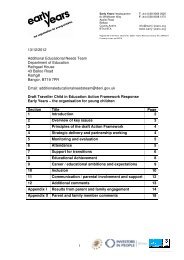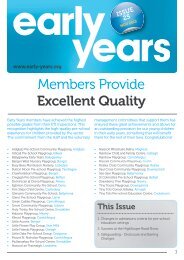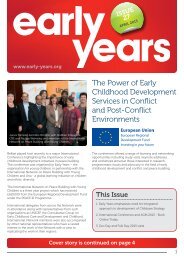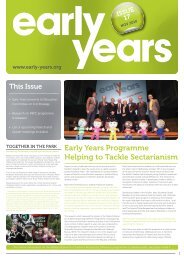Learning from Nine Examples of Peacebuilding Evaluation
Learning from Nine Examples of Peacebuilding Evaluation
Learning from Nine Examples of Peacebuilding Evaluation
You also want an ePaper? Increase the reach of your titles
YUMPU automatically turns print PDFs into web optimized ePapers that Google loves.
<strong>Evaluation</strong> Strategy<br />
At the start <strong>of</strong> their evaluation planning, GPPAC acknowledged that as a network<br />
<strong>of</strong> networks, impact is the product <strong>of</strong> a confluence <strong>of</strong> factors and is<br />
therefore diffuse and <strong>of</strong>ten hard to trace. As a result, GPPAC decided that<br />
many traditional evaluation methods were not well suited to their work. Instead,<br />
they chose a method termed Outcome Harvesting, a variation <strong>of</strong> the<br />
Outcome Mapping approach developed by the International Development<br />
Research Centre.<br />
To focus the evaluation, GPPAC assessed one specific outcome: the change<br />
in the behavior, relations, and actions <strong>of</strong> actors that GPPAC believed it had<br />
influenced. The heart <strong>of</strong> the evaluation was an Outcome Harvesting process<br />
that collected data <strong>from</strong> GPPAC members through the following set <strong>of</strong><br />
prompts:<br />
• In a sentence, summarize the change in a given social actor. That is, which<br />
social actor did what was new or different<br />
• Describe who changed, what changed in their behavior, relationships,<br />
activities, or actions, when, and where.<br />
• Briefly explain why the outcome is important.<br />
• How was the outcome a result—partially or totally, directly or indirectly,<br />
intentionally or not—<strong>of</strong> GPPAC’s activities<br />
13<br />
This data gathering process was combined with a set <strong>of</strong> review, substantiation,<br />
analysis, and use support strategies.<br />
Given that the evaluation looked at a full range <strong>of</strong> GPPAC programming, the<br />
findings are too complex to summarize here. GPPAC did report on some topline<br />
lessons, including: 1) the need to sow many seeds as not all activities<br />
will create results; 2) causality can be partial, indirect, or unintended, but still<br />
significant; and 3) outcomes harvested repeatedly can show both impact and<br />
processes <strong>of</strong> change.<br />
Considerations on the Methodology<br />
Strengths<br />
• Outcome Mapping has proven a useful methodology to investigate complex<br />
change processes. For GPPAC, the methodology was appropriate since as a<br />
complex network its impact is the product <strong>of</strong> interactions between networks,<br />
members, and stakeholders. Thus, in an environment where establishing<br />
causality and direct attribution was not possible given GPPAC resources, the<br />
Outcome Mapping approach created a means for GPPAC to communicate its<br />
contributions to its stakeholders and funders.














